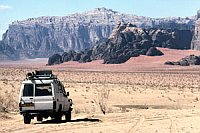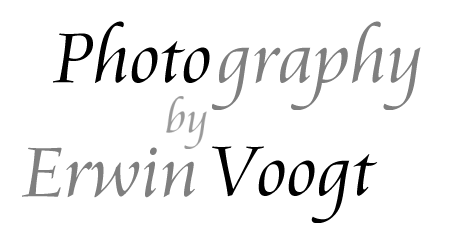
Sevenhundred and thirty-two days later we were back where we came from: The Netherlands. Exactly two years.
By car, a Toyota LandCruiser BJ75, we wanted to travel from our hometown Utrecht (The Netherlands) to at least Lhasa (Tibet), but the outbreak of SARS in 2003 blocked the final stretch of our route. The government of China refused to issue visas for months when we were in Kathmandu. But this was just a minor hiccup compared to falling off the mountain with our LandCruiser in Pakistan, getting frozen fingers at 6000 meters in Nepal, getting our car smashed during the riots in Islamabad and arriving in Bam the day after the devastating earthquake. These and many other stories you will find on this website!
Now that we are back we'll be able to scan our slides and add them to this website, so:
Stay connected!
Erwin Voogt and Bastienne Wentzel
Topics on this site
English
Nederlands
Where have we been in each country:
Images, photographs, pictures...



The LandCruiser
The Toyota LandCruiser is probably the most reliable car ever build. We bought a BJ75 dating from 1988. This version has the 4 cylinder 3.4 liter diesel engine. In most cases the post 1992 HZJ75 with the 6 cylinder 4.2 liter diesel engine would be favourite. However, most Asian countries require a very expensive Carnet de Passage, related to the age, or actually the original commercial price, of the vehicle. So choosing for some extra engine power, would also mean spending a lot of extra money. The 3.4 liter is a little bit slow on highways, but still a mighty engine off the road. And remember, most Land Rovers have much smaller engines.Note:
You don't need a 4WD vehicle to drive to India or Nepal. Actually, the most common car with European licence plates you will see on the beach of Goa is the Mercedes 307 or 508 van. Also Toyota Hi-aces are very reliable and well suited for Third World roads and mechanics - it is the most popular van in the (Third) World. However, if you want to do serious driving in the Karakoram or the Iranian desert and mountain areas, you will need a 4WD vehicle.
Contrary to the information given by Lonely Planet (they never travelled by car, I suppose), European cars like Landrover, Volkswagen and even Mercedes are very uncommon in Asia. Japanese cars, especially Toyota, dominate the streets. In India, outside the big cities only local made cars are available.
Land Rovers look cute, but think twice if you want to travel with one and you are not a mechanic. They have the repution to break down very often and lack the strength for continuous travel on bumpy and rocky Karakoram roads. Although most Land Rover owners love their vehicle, the break downs we have seen with Land Rovers would have meant big problems for non-technical people like us.
The same seems to apply for the (post 1980) Volkswagen Combi (Transporter): many breakdowns and spare parts are unavailable outside Europe.
In general: a simple diesel engine (no electronics and may be not even a turbo charger) is best suited for Third World use. They are easy to repair and don't give problems with low quality fuel or engine oil.
Carnet de Passages en Douane
To enter Asian and African countries with your own vehicle a Carnet de Passage is required. It is a document to ensure that you export the vehicle again after you have imported it. Without a Carnet you will have to pay the import tax, commonly a few times the value of the car, at the border on arrival. You'd better get a Carnet!A Carnet de Passage is issued by the motoring organisation ("AA") of your country. In The Netherlands you have to contact the "Afdeling Grensdocumenten" of the ANWB (update: the ANWB referrals to the ADAC, see the navigation bar below).
Of course a booklet and a few stamps only will not keep people from selling their vehicle. Therefore you will have to lodge a deposit or bank guarantee to secure the Carnet. The amount used to be approximately the original selling price of the car in the year of build. Fortunately, by using an insurance construction the ANWB was able to lower the amount for the deposit or bank guarantee. The required bank guarantee is now about 1.5 times the actual value of the vehicle. The price of the Carnet itself is a few hunderd euros.
You will loose your deposit or bank guarantee when you have an incomplete set of "in" and "out" stamps, and you can not prove the car was destroyed or stolen. Especially the latter will face you with a lot of bureaucracy. But when your car is stolen, you are in big trouble anyway...
Even with a Carnet your car is only allowed for a limited period in a country duty free. For India the maximum stay within 365 days is 180 days. Do not exceed the 180 day period because they will check for it at the border and even a one day overstay can result in fine surpassing the value of your car! In Pakistan the maximum stay is 3 months but this can be extended via some bureaucracy at the Revenue Department, Constitution Avenue, Islamabad. Generally the Pakistani custom officers tend to be more relaxed and helpful than the Indian ones.
We did not check the custom rules of Nepal ourselves, but from hearsay we know that the maximum allowed period for your vehicle is 6 months. Check the custom rules if you are planning to stay longer than 3 months with your vehicle in any country.
Although it is not necessary to use a Carnet to enter your vehicle into Turkey, by doing so you can import your vehicle for free. Otherwise it will cost you about 10 euro.
Iran can be entered without a Carnet, but expect to pay a customs fee of at least $100 (for a small vehicle) and quite some hassle.
Note:
A Carnet de Passage is not valid in China or Birma/Myanmar!
Entering Birma with your own vehicle is out of the question, entering China is possible but the following rules apply:
- You have to pay $75 per day.
- You can only follow a preset route, a guide (inside your car...) will prevent you from deviating from this route.
- You will have to leave a deposit of $10.000 in cash at the border ($4000 for motorcycles).
We got this information from an agent in Kathmandu specialised in Tibet tours. Since rules in China can change quickly and Birma is slowly opening up, don't hesitate to inform yourself (and you are welcome to send an update to us).
This note was written on 21 May 2003.
It is possible to contract a travel company to do all the paperwork for entering China. Expect to pay about 5000 euro per vehicle, but then the travel company will arrange the mandatory guide and will deal with the deposit and the fees.
Additional costs at the borders
In Turkey, Iran, Pakistan, India and Nepal there should be no additional costs for entering or leaving the country. However, notorious bribe-beggers are the Iranian custom officers at the border between Turkey and Iran and the Pakistani custom officers at the border between India and Pakistan. Simply refuse to pay.
The so-called "diesel tax" in Iran, which is even mentioned in the Lonely Planet, is a bribe. Again, simply refuse to pay.
In Jordan you have to pay JD12 (US$18) as a fee for processing you Carnet. You get an official printed recipe for this, so it seems to be OK. You also have to pay for the liability insurance, see below. When leaving Jordan you have to pay a departure tax of JD5 (US$7.50) for each person and for each vehicle. A nasty goodbye.
In Syria there is the infamous diesel tax for foreigners with a diesel car. If you don't convert your vehicle into a petrol car you will have to pay $100 tax per week. Contrary to Iran, this tax is official and both when entering and leaving the country you will be questioned about the fuel your vehicle is running on. When entering and leaving Syria there is besides the insurance (see below) a customs fee of US$10 and US$4 respectively. Paying in Syrian pounds is not possible.
Lebanon can not be entered with a diesel car, but trucks could/should be OK. We did try to enter Lebanon with our diesel LandCruiser, but a customs official got suspicious and checked the engine. However, parking the car for one week at the border was no problem.
Leaving a country without your vehicle
In Turkey, Iran, Pakistan, India and Syria a vehicle registration will be stamped into your passport. To leave these countries without your vehicle is only possible by leaving your vehicle at a customs department.
Jordan and Nepal border officials do not register your vehicle in your passport and therefore these countries can be used as long term parking places.
Insurance
You need at least an health insurance for yourself and a liability insurance for the car.With a bit of luck Iran is included on your Green-card for the liability insurance. In The Netherlands the insurance company FBTO, for example, has included Iran in the coverage. For the other countries a liability insurance has to be bought at the border, see below.
There are a few health insurance policies available for expats and globetrotters. In The Netherlands Allianz (Elvia) and De Europeesche have a globetrotter policy.
For us, the policy of De Goudse fitted our needs best, especially because it is not limited to 12 or 18 months. However, it is not clear if the company still supports this product.
Liability insurance for the car
In Pakistan we had no liability insurance because we got no information about where to obtain one. Maybe we ought to have looked better in Quetta.
However, in India it is easy to obtain a liability insurance for the whole Subcontinent, thus including Pakistan, Nepal and Bangladesh. We got our insurance at the following company in Amritsar:
United India Insurance Co. Ltd.
Malviya road - 1st floor, above "Hero Honda"
Amritsar
GPS: N31°38'17.5" E74°52'31.9"
One year liability insurance for our car cost Rs 893 = $19.
Make sure that you make clear that your car is a private vehicle and not a "goods carrying vehicle". The one tonne maximum payload of our LandCruiser led to some misunderstanding about the type of vehicle and we almost ended up paying a five times higher premium!
In Syria and Jordan your are recruired to buy a liability insurance at the border from the respective government insurance companies. The one month rates in 2004 for small vehicles are US$29 in Syria and JD28 (US$42) in Jordan.
